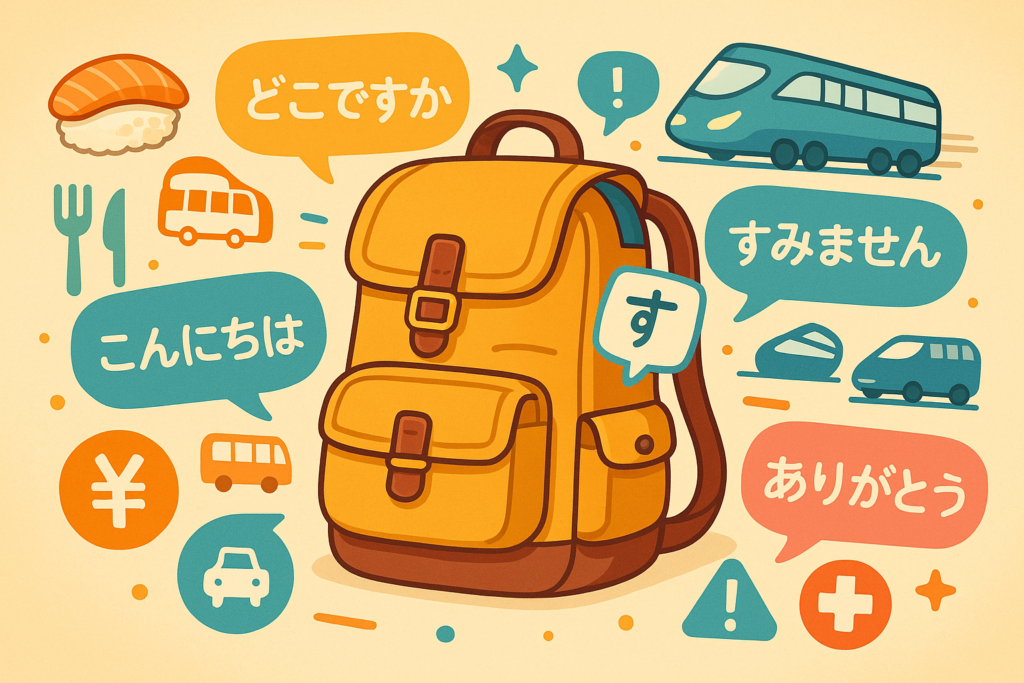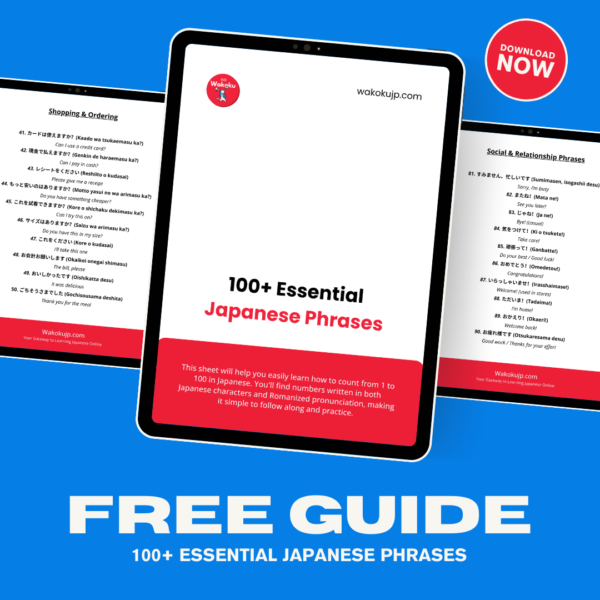Have you ever found yourself in a situation where you desperately needed to communicate in Japanese but couldn’t find the right words? Whether you’re planning a trip to Tokyo, trying to impress your Japanese friends, or simply passionate about learning a new language, having an essential Japanese vocabulary PDF at your fingertips can be a game-changer.
As someone who’s been teaching Japanese for over 10 years, I’ve seen countless students struggle with memorizing key phrases and vocabulary. The good news? You don’t need to learn thousands of words to start having meaningful conversations. With just 100+ carefully selected phrases, you can navigate most everyday situations with confidence.
In this comprehensive guide, I’ll walk you through the most important Japanese phrases every beginner should know, explain how to use them in real-life contexts, and share my proven methods for vocabulary retention. Plus, I’ll show you how to access my free essential Japanese vocabulary PDF that compiles all these phrases in one convenient, printable resource.
Why You Need an Essential Japanese Vocabulary PDF
Learning a new language can feel overwhelming. With Japanese, you’re confronting three writing systems (hiragana, katakana, and kanji), unfamiliar grammar patterns, and vocabulary that bears little resemblance to English. It’s easy to get lost in textbooks that introduce hundreds of words at once.
This is where an essential Japanese vocabulary PDF becomes invaluable:
- Portability: Access your vocabulary list anytime, anywhere – even offline
- Focus: Concentrate on high-frequency words and phrases that you’ll actually use
- Structure: Learn systematically instead of randomly picking up words
- Reference: Quickly look up phrases in social situations without fumbling through apps
- Pronunciation: See romaji (latinized spelling) alongside Japanese characters
In my experience teaching thousands of students, those who began with a core set of essential phrases progressed much faster than those who tried to absorb everything at once. As I explained in my Japanese Numbers 1-100 article, mastering the fundamentals first creates a strong foundation for more advanced learning later.
Basic Japanese Greetings: Your First Conversation Starters
The journey to Japanese fluency begins with simple greetings. These phrases form the foundation of every interaction and can instantly create goodwill when meeting Japanese speakers.
Morning, Afternoon, and Evening Greetings
| Japanese | Romaji | English | Usage Context |
|---|---|---|---|
| おはようございます | Ohayou gozaimasu | Good morning | Use until around 10:30 AM |
| こんにちは | Konnichiwa | Hello/Good afternoon | Use from late morning until sunset |
| こんばんは | Konbanwa | Good evening | Use after sunset |
Real-life example: When entering a shop in the morning, you might say:
おはようございます。素敵な日ですね。
Ohayou gozaimasu. Suteki na hi desu ne.
Good morning. It's a lovely day, isn't it?
Essential Thank You and Sorry Expressions
Politeness is highly valued in Japanese culture, making these phrases particularly important:
| Japanese | Romaji | English | Usage Context |
|---|---|---|---|
| ありがとうございます | Arigatou gozaimasu | Thank you (formal) | Use in business or with strangers |
| どうもありがとう | Doumo arigatou | Thank you very much | Semi-formal, good for most situations |
| すみません | Sumimasen | Excuse me/I’m sorry | Multifunctional – use to apologize, get attention, or even thank someone |
| ごめんなさい | Gomen nasai | I’m sorry | For apologizing in most situations |
The phrase “sumimasen” is particularly versatile in Japanese. It can mean:
- “Excuse me” (when trying to get someone’s attention)
- “I’m sorry” (when apologizing)
- “Thank you” (when acknowledging someone’s help or inconvenience)
Essential Japanese Phrases for Travelers
If you’re planning a trip to Japan, these phrases will be your lifeline. I’ve carefully selected the most practical expressions that can help you navigate various travel situations.
Finding Your Way Around
| Japanese | Romaji | English |
|---|---|---|
| トイレはどこですか? | Toire wa doko desu ka? | Where is the toilet? |
| 駅はどこですか? | Eki wa doko desu ka? | Where is the train station? |
| これはいくらですか? | Kore wa ikura desu ka? | How much is this? |
| 〜に行きたいです | 〜ni ikitai desu | I want to go to 〜 |
Travel tip: When asking for directions, it’s helpful to point to the destination on a map while saying: “〜はどこですか?” (〜 wa doko desu ka?). This visual reference can overcome language barriers.
Restaurant and Food Phrases
The Japanese dining experience is enhanced when you can order in the local language:
| Japanese | Romaji | English |
|---|---|---|
| メニューをください | Menyuu o kudasai | Please give me a menu |
| おすすめは何ですか? | Osusume wa nan desu ka? | What do you recommend? |
| 水をください | Mizu o kudasai | Please give me water |
| おいしいです | Oishii desu | It’s delicious |
| お会計お願いします | Okaikei onegaishimasu | The bill, please |
Cultural note: After finishing your meal, it’s customary to say “ごちそうさまでした” (Gochisousama deshita), which roughly translates to “Thank you for the feast.” This phrase shows appreciation for the food and the effort that went into preparing it.
Self-Introduction and Basic Conversation Phrases
Being able to introduce yourself and maintain simple conversations is essential for building relationships:
| Japanese | Romaji | English |
|---|---|---|
| 初めまして | Hajimemashite | Nice to meet you |
| 私の名前は〜です | Watashi no namae wa 〜 desu | My name is 〜 |
| よろしくお願いします | Yoroshiku onegaishimasu | Please treat me well (said after introductions) |
| 日本語が少し話せます | Nihongo ga sukoshi hanasemasu | I can speak a little Japanese |
| 分かりません | Wakarimasen | I don’t understand |
| もう一度お願いします | Mou ichido onegai shimasu | Please say that again |
Conversation example:
A: 初めまして。私の名前はマイクです。よろしくお願いします。
Hajimemashite. Watashi no namae wa Maiku desu. Yoroshiku onegaishimasu.
Nice to meet you. My name is Mike. Please treat me well.
B: マイクさん、初めまして。私はなおこです。英語が話せますか?
Maiku-san, hajimemashite. Watashi wa Naoko desu. Eigo ga hanasemasuka?
Nice to meet you, Mike. I'm Naoko. Do you speak English?
A: はい、少し話せます。日本語も勉強しています。
Hai, sukoshi hanasemasu. Nihongo mo benkyou shiteimasu.
Yes, I speak a little. I'm also studying Japanese.
Emergency and Health-Related Japanese Phrases
Being prepared for emergencies is crucial when traveling or living in a foreign country. These phrases could be lifesavers:
| Japanese | Romaji | English |
|---|---|---|
| 助けてください! | Tasukete kudasai! | Please help! |
| 警察を呼んでください | Keisatsu o yonde kudasai | Please call the police |
| 救急車を呼んでください | Kyuukyuusha o yonde kudasai | Please call an ambulance |
| 具合が悪いです | Guai ga warui desu | I don’t feel well |
| 病院はどこですか? | Byouin wa doko desu ka? | Where is the hospital? |
Pro tip: Save these phrases in your phone’s notes app, along with a downloaded copy of the essential Japanese vocabulary PDF. This ensures you can access them even without internet connectivity.
Want to explore Japan’s culture?
Discover Japan’s rich culture, traditions, and hidden gems with our expertly crafted guides. Get insider tips on travel, food, and history. All for free!
How to Use Your Essential Japanese Vocabulary PDF Effectively
Simply downloading an essential Japanese vocabulary PDF isn’t enough—you need to use it strategically to maximize learning. Based on my experience with thousands of students, here are the most effective methods:
1. The Five-a-Day Method
Rather than trying to memorize all 100+ phrases at once, focus on just five phrases per day:
- Select five related phrases (e.g., all restaurant phrases)
- Practice saying them aloud 10 times each
- Create flashcards with Japanese on one side, English on the other
- Review throughout the day when you have spare moments
- Before bed, test yourself on all five phrases
2. Situation-Based Immersion
Prepare for specific scenarios by practicing relevant phrases:
- Identify upcoming situations (e.g., ordering at a restaurant)
- Find all related phrases in your essential Japanese vocabulary PDF
- Role-play the scenario with a friend or language exchange partner
- Record yourself saying the phrases and listen to the recordings
- Compare your pronunciation with native speakers (using language apps)
As I discussed in my Japanese Grammar Lessons article, contextual learning is far more effective than rote memorization. When you attach phrases to real-life situations, they move from short-term to long-term memory.
3. Spaced Repetition System
This scientifically-proven method optimizes review timing:
- Day 1: Learn new phrases
- Day 2: Review
- Day 4: Review
- Day 7: Review
- Day 14: Review
- Day 30: Review
Each review strengthens neural connections and makes recall easier. Digital flashcard apps can automate this process, but you can also use your essential Japanese vocabulary PDF with a simple calendar system.
Beyond the Basics: Adding Context to Your Essential Phrases
Understanding when and how to use phrases appropriately is just as important as knowing the phrases themselves. Here are some cultural insights that will help you use your essential Japanese vocabulary PDF more effectively:
Levels of Politeness
Japanese has multiple politeness levels. In your essential Japanese vocabulary PDF, you’ll find phrases marked with different politeness indicators:
- Casual: Used with close friends and family (e.g., ありがとう – Arigatou)
- Polite: Standard politeness for most situations (e.g., ありがとうございます – Arigatou gozaimasu)
- Very Polite: Used in formal or business settings (e.g., ありがとうございました – Arigatou gozaimashita)
As a beginner, sticking with polite forms is safest until you develop a better feel for the language and its social contexts.
The Magic of Yoroshiku
The phrase “よろしくお願いします” (yoroshiku onegaishimasu) is notoriously difficult to translate but incredibly useful. Depending on context, it can mean:
- “Nice to meet you” (after introductions)
- “Please treat me well/take care of me”
- “I’m counting on you” (when making a request)
- “Please look favorably upon [something]”
This versatile expression appears frequently in our essential Japanese vocabulary PDF because of its importance in social interactions.
When Silence is Golden
Japanese communication often values implicit understanding and non-verbal cues. Sometimes, the most appropriate “phrase” is silence or a simple nod. While your essential Japanese vocabulary PDF provides important verbal tools, remember that being observant and respectful of non-verbal communication is equally important.
Common Challenges and How to Overcome Them
Even with an essential Japanese vocabulary PDF, learners often encounter specific challenges. Here’s how to address the most common ones:
Challenge 1: Pronunciation
Japanese pronunciation is relatively straightforward, but certain sounds can be tricky for English speakers:
- The “r” sound (more like a flapped “d” and “l” hybrid)
- Long vowels (indicated by macrons in romaji, like ō)
- The rhythm and pitch accent of words
Solution: Use audio resources alongside your essential Japanese vocabulary PDF. Listen carefully to native pronunciation and practice mimicking the sounds. Recording yourself can help identify areas for improvement.
Challenge 2: Remembering Kanji
While our essential Japanese vocabulary PDF includes romaji, ultimately you’ll want to recognize Japanese characters.
Solution: Start with hiragana and katakana, then gradually introduce kanji. Use mnemonic techniques to associate characters with visual stories or images. For example, the kanji for “tree” (木) literally looks like a tree.
Challenge 3: Knowing When to Use Which Phrase
Having multiple phrases for similar situations can be confusing.
Solution: Make notes in your essential Japanese vocabulary PDF about specific contexts. For instance, note that “おはようございます” (ohayou gozaimasu) is specifically for mornings, while “こんにちは” (konnichiwa) is for afternoons.
Expanding Your Japanese Vocabulary Beyond the PDF
While an essential Japanese vocabulary PDF provides a solid foundation, language learning is an ongoing journey. Here are strategies to continue building your vocabulary:
1. Thematic Vocabulary Building
Once you’ve mastered the basics, expand by focusing on specific themes:
- Food and cooking terminology
- Business and workplace vocabulary
- Hobby-specific words (for anime, music, sports, etc.)
- Travel and transportation terms
2. Learning Through Media
Immerse yourself in Japanese content:
- Watch Japanese YouTubers with subtitles
- Listen to Japanese music and translate lyrics
- Read manga with furigana (pronunciation guides)
- Use language learning apps that feature native content
3. Regular Practice with Native Speakers
Nothing reinforces vocabulary like real conversation:
- Find language exchange partners online
- Join Japanese conversation groups
- Take structured classes with native teachers
- Visit Japan if possible
Get Your Free Essential Japanese Vocabulary PDF
To accelerate your Japanese learning journey, I’ve compiled all these phrases and more into a comprehensive, printable resource. My 100+ Essential Japanese Phrases PDF includes:
- 100+ carefully selected phrases organized by situation
- Japanese script, romaji pronunciation, and English translations
- Cultural notes and usage tips for each phrase
- Examples showing phrases in context
- Pronunciation guides for tricky sounds
Download the 100+ Essential Japanese Phrases PDF for free from our resources page and start building your Japanese fluency today. This guide is perfect for:
- First-time travelers to Japan
- Japanese language beginners
- Business professionals working with Japanese companies
- Anime and manga enthusiasts
- Anyone interested in Japanese culture
FAQ: Essential Japanese Vocabulary
How many Japanese words do I need to know as a beginner?
A beginner needs to know approximately 500-1,000 essential Japanese vocabulary words to handle basic daily conversations, with the most crucial 100+ phrases included in our essential Japanese vocabulary PDF.
What is the fastest way to learn Japanese vocabulary?
The fastest way to learn Japanese vocabulary is through consistent daily practice using spaced repetition systems, contextual learning, and immersion techniques like watching Japanese media with subtitles.
Is it better to learn Japanese words with kanji or romaji?
It’s better to learn Japanese words with both kanji and romaji initially, using romaji as a pronunciation guide while gradually building recognition of kanji characters for long-term proficiency.
How long does it take to learn basic conversational Japanese?
Learning basic conversational Japanese typically takes 3-6 months of consistent study, focusing on essential vocabulary and phrases like those found in our comprehensive Japanese vocabulary PDF.
What are the most important Japanese phrases for tourists?
The most important Japanese phrases for tourists include basic greetings (konnichiwa), thank you expressions (arigatou gozaimasu), asking for directions (doko desu ka), ordering food, and emergency phrases.
Conclusion: Your Japanese Learning Journey Begins Here
Mastering a new language doesn’t happen overnight, but with the right tools and approach, you can make remarkable progress in a short time. An essential Japanese vocabulary PDF serves as both your starting point and your constant companion on this journey.
By focusing on high-frequency phrases, practicing consistently, and applying the strategies outlined in this guide, you’ll build confidence in your Japanese communication skills. Whether you’re preparing for a trip to Japan, enhancing your appreciation of Japanese media, or laying the groundwork for fluency, these essential phrases form the foundation of your success.
Don’t forget to download your free 100+ Essential Japanese Phrases PDF from our resources page and take the first step toward Japanese language proficiency. The path to fluency begins with that first “こんにちは” (konnichiwa)!
What phrase are you most excited to use in your next Japanese conversation? Share in the comments below!
Love Japan? Stay in the Loop!
Get the best of Japan straight to your inbox: language, culture & travel insights!





